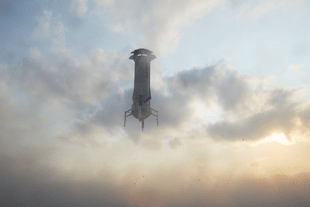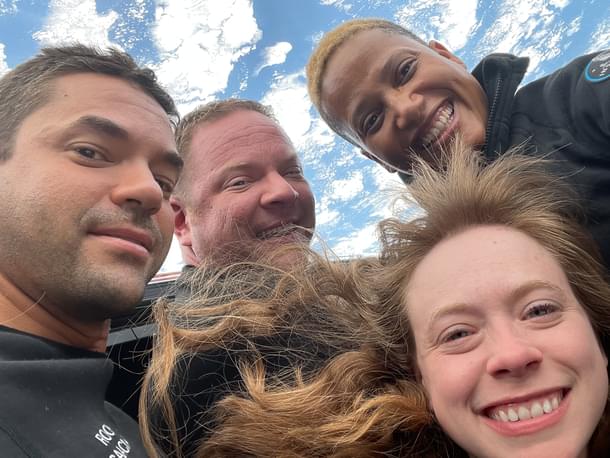Science
Next Blue Origin Human Flight On 12 October: Planet Labs Co-Founder Among Four Space Passengers To Fly
Karan Kamble
Sep 28, 2021, 05:04 AM | Updated Sep 28, 2021, 05:46 AM IST
Save & read from anywhere!
Bookmark stories for easy access on any device or the Swarajya app.


Amazon founder Jeffrey Bezos’ space venture Blue Origin is all set for a second crewed flight to space and back on 12 October.
Four space tourists will fly on New Shepard’s eighteenth mission, NS-18, from Launch Site One in West Texas at 8:30 am CDT (Central Daylight Time) or 1:30 pm UTC (Coordinated Universal Time), which translates to 7 pm on Tuesday, 12 October, in Indian Standard Time.
Former engineer with the National Aeronautics and Space Administration (NASA) and co-founder of Earth imaging company Planet Labs, Dr Chris Boshuizen, will be flying along with the Vice Chair of Life Sciences and Healthcare at French software company Dassault Systèmes and co-founder of medical technology company Medidata, Glen de Vries.
The names of two other space passengers, as per a Blue Origin statement, will be announced in the coming days.
Boshuizen posted an ecstatic video message upon confirmation, which he shared along with a tweet.
“This has been a dream of mine my entire life and I am so excited to finally make it happen as part of the next New Shepard crew,” Boshuizen tweeted, adding that the news of him going to space hasn’t sunk in yet.
“I’ve been passionate about aviation and space for as long as I can remember, and a long-awaited dream of mine is about to become a reality,” de Vries said in a tweet.
Boshuizen worked at NASA’s Ames Research Center from 2008 to 2012. He co-founded Planet Labs in 2010, which images the Earth every day.
Glen de Vries is behind Medidata Solutions, the world’s most used clinical research platform, which he co-founded in 1999. Medidata was acquired by Dassault Systèmes in 2019.
Besides Boshuizen, de Vries, and two other space tourists, Blue Origin’s second human spaceflight will carry thousands of postcards from the space company’s foundation, “Club for the Future”.
These “postcards to space” contain students’ vision of what life in space will look like someday, including notes to self. The cards will be flown to space and back, and returned to their respective student owners with the “flown to space” stamp.
The planned 12 October NS-18 mission follows the maiden Blue Origin human spaceflight, completed successfully on 20 July.
The first flight carried a four-member crew as well. Jeff Bezos and his younger brother Mark Bezos, along with 18-year-old student and Blue Origin’s first paying customer Oliver Daemen and 82-year-old Mercury 13 aviator Wally Funk, lifted up to the skies on board the reusable suborbital rocket New Shepard before descending safe and sound back to the ground in the West Texas desert.
Funk and Daemen got their names written into the history books as the oldest and youngest persons to ever fly to space respectively.
It marked Blue Origin’s sixteenth New Shepard flight to space, but only the first one ferrying passengers. As part of the mission, they crossed the “Kármán line” — named after Hungarian physicist Theodore von Kármán and recognised as an imaginary boundary separating the Earth’s atmosphere and outer space, about 100 km above mean sea level.
Bezos' milestone flight had taken place just nine days after Virgin Galactic blasted off towards space on 11 July.
Virgin Galactic founder Richard Branson was part of the crew that flew on board VSS Unity, registering the company’s fourth rocket-powered spaceflight and the fourth with crew.
One of the mission specialists on the Virgin Galactic spaceflight, professional astronaut Sirisha Bandla, had even travelled with the goal of scientific research. She conducted a NASA-supported plant experiment on the Unity 22 flight.
More recently, the world’s first all-civilian mission to orbit, called “Inspiration4”, was accomplished successfully.

The crew was lifted up to space on a SpaceX Falcon 9 rocket on 15 September from Launch Complex 39A at NASA’s Kennedy Space Center in Florida. They spent three days orbiting the Earth on SpaceX’s Dragon spacecraft before safely splashing down in the Atlantic Ocean off the coast of Kennedy Space Center.
At an orbit of about 575 km, SpaceX's Inspiration4 mission went well beyond the relatively modest suborbital altitudes of the Blue Origin and Virgin Galactic flights to record the farthest flight for a human spaceflight since the Hubble missions.
The spaceflight ambitions of Bezos, Branson, and Elon Musk have come under criticism by some. The "billionaire space race" is being perceived by critics as wasteful ventures of the ultra rich.
However, a new era of commercial spaceflight is opening up with these private civilian missions that are promising to make space more accessible and, at a later time, affordable.
Also Read: For Jeff Bezos, Space Tourism Is “Practice” For Loftier Space Goals





